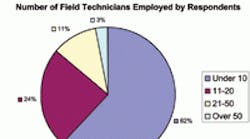PROFILE OF THE RESPONDENTS
Approximately 10% of the ACCA membership returned a completed survey. These responders are a representative mix of contractor sizes: 62% of the respondents employ ten or fewer technicians, 25% have 11 to 20 technicians, 11% have 21 to 50 technicians, and 3% of the respondents indicated they have more than 50 technicians in the field.
Additionally, the responders indicated that they work in varying HVAC sectors: 93% perform work in the residential sector, 92% in the commercial sectors, 39% in commercial refrigeration, and 23% in the industrial sector (multiple options permitted). The sizes of the contracting entities and the mix of their sector emphasis are roughly reflective of the U.S. contracting industry.
More than 90% of HVACR equipment is either received at scrap yards or at an appropriate recyclingtransferfacility. Only a small fraction of contractors indicated that it's their usual procedure to dispose of the equipment in some alternate manner, or even to leave the equipment for customer disposal.
Glenn C. Hourahan is vice president of research and technology for the Air Conditioning Contractors of America (ACCA), Arlington, VA. He can be reached at 703/824-8865, e-mail [email protected].
When one thinks about the environmental impact of HVACR equipment, initial thoughts usually turn to the extent of energy use, or the potential of atmospheric harm if refrigerants are inappropriately released. The effect of decommissioned equipment on the nation's waste stream is generally disregarded.
Anecdotal information indicates that the residual value (i.e., scrap value of the copper, aluminum, steel) of HVACR equipment is adequately valued by the existing recovery / salvage infrastructure. This implies that HVAC equipment doesn't appear inappropriately at landfills or other dumping locations.
To obtain a better understanding of contractor recycling activities, the Air Conditioning Contractors of America (ACCA) undertook a survey to ascertain field practice for decommissioning HVACR equipment.
ACCA solicited information to gauge the frequency of various disposal options that contractors use for different equipment types. It was recognized that a contractor's standard practice might include the occasional usage of other disposal options; so a variety of responses were allowed, to help arrive at an accurate profile of what is actually occurring in the field.
Since the survey accepted multiple responses (such as "never," "rarely," "sometimes," etc.) for the various disposal options, some simplifications were used so that trends could be more easily presented for each equipment category. For this summary, the responses were grouped into two categories: " Always and Often," and "Rarely and "Sometimes"
As the accompanying chart shows, more than 90% of HVACR equipment is either received at scrap yards or at an appropriate recycling-transfer facility.
Only a small fraction of contractors indicated that it's their usual (i.e., "often" or "always") procedure to dispose of the equipment in some alternate manner, or even to leave the equipment for customer disposal.
The extent to which the small percentage of "other" disposal options are used within the contracting community is also of value to review.
Although the responders may only "Rarely" or "Sometimes" utilize a disposal option different from their norms, these alternate methods are generally still material recovery approaches that pull economic value out of the waste stream.
Not surprisingly, about 15% of the contractors indicated that they sometimes retain equipment for possible resale in the secondary market, for emergency use by customers, or to cannibalize for parts.
What is surprising is that about 7% of the responders indicated that they may occasionally leave HVACR equipment behind for customer disposal. Obviously, this would be based on customer preference. Perhaps the customer has a secondary use for the equipment, is seeking scrap value elsewhere, or has a disposal option cheaper than what the contractor was proposing to charge.
This survey found that the vast majority (more than 90%) of HVACR equipment is taken to facilities positioned to recoup value out of the waste stream. A small percentage of the balance (less than 5%) isn't immediately returned to a recycling facility, and there are indications that some of this equipment may be taken to dumps and other similar venues. Although the percentages here are small, the industry needs to ascertain how these alternate venues are actually disposing of the equipment and components. In addition, it would appear that there's an opportunity to educate contractors on the value of decommissioned materials they might otherwise be ignoring.
Give us your feedback on this article at [email protected]









